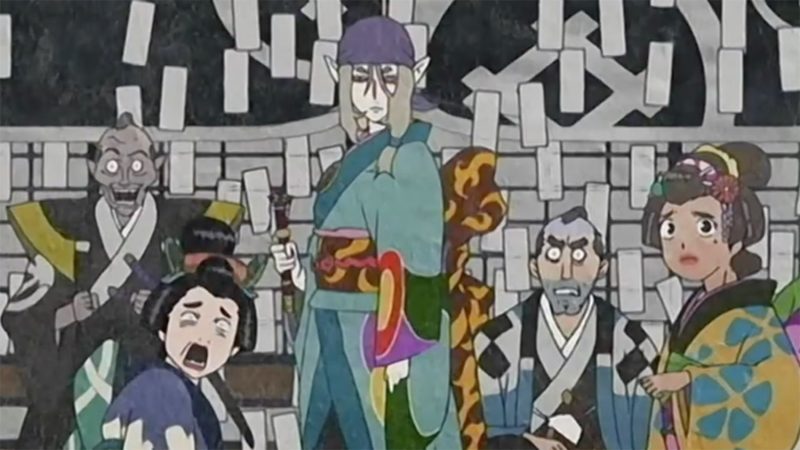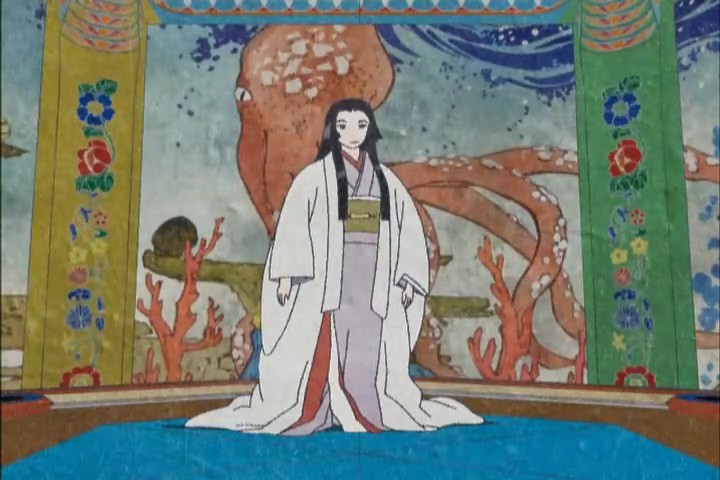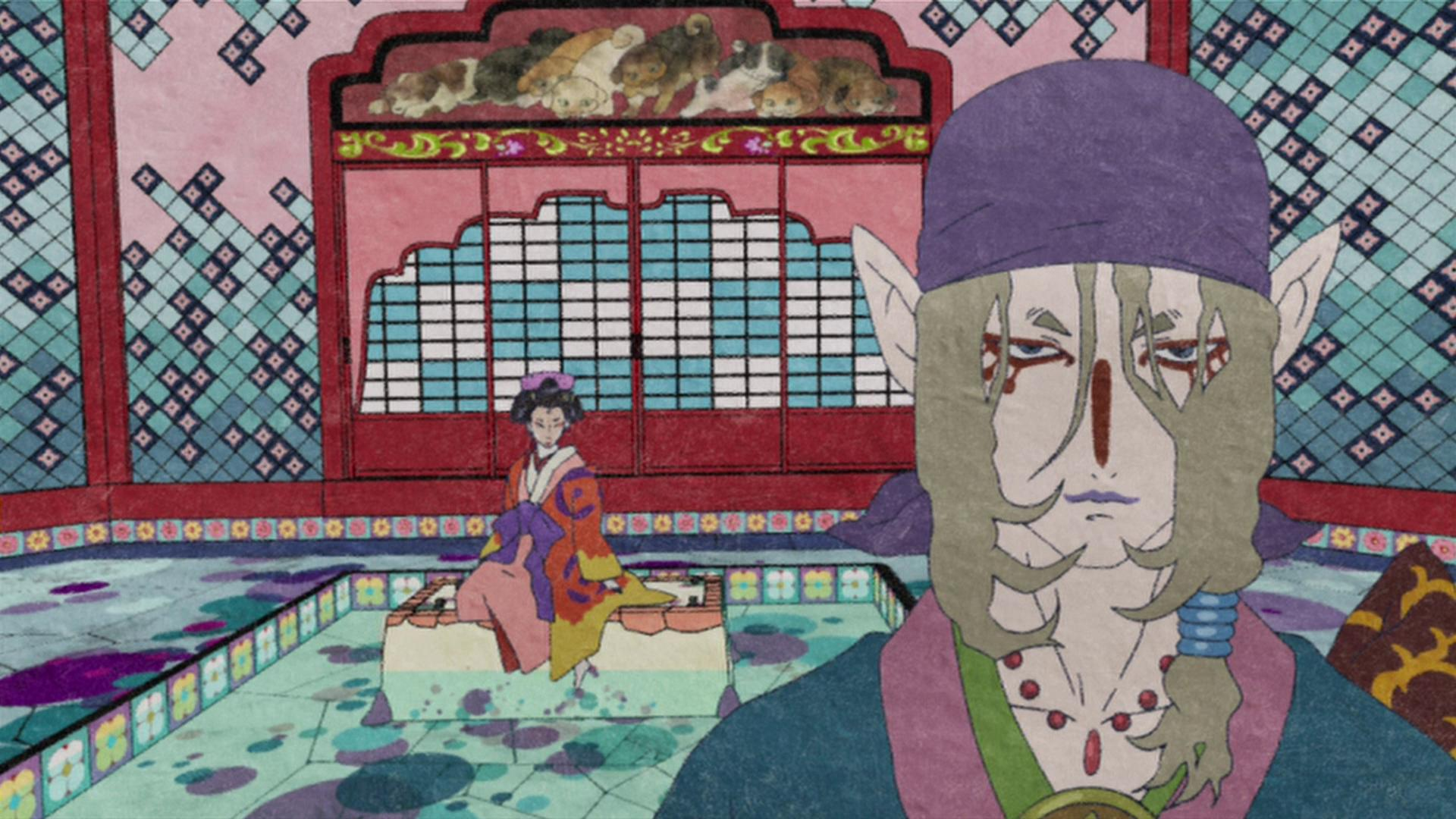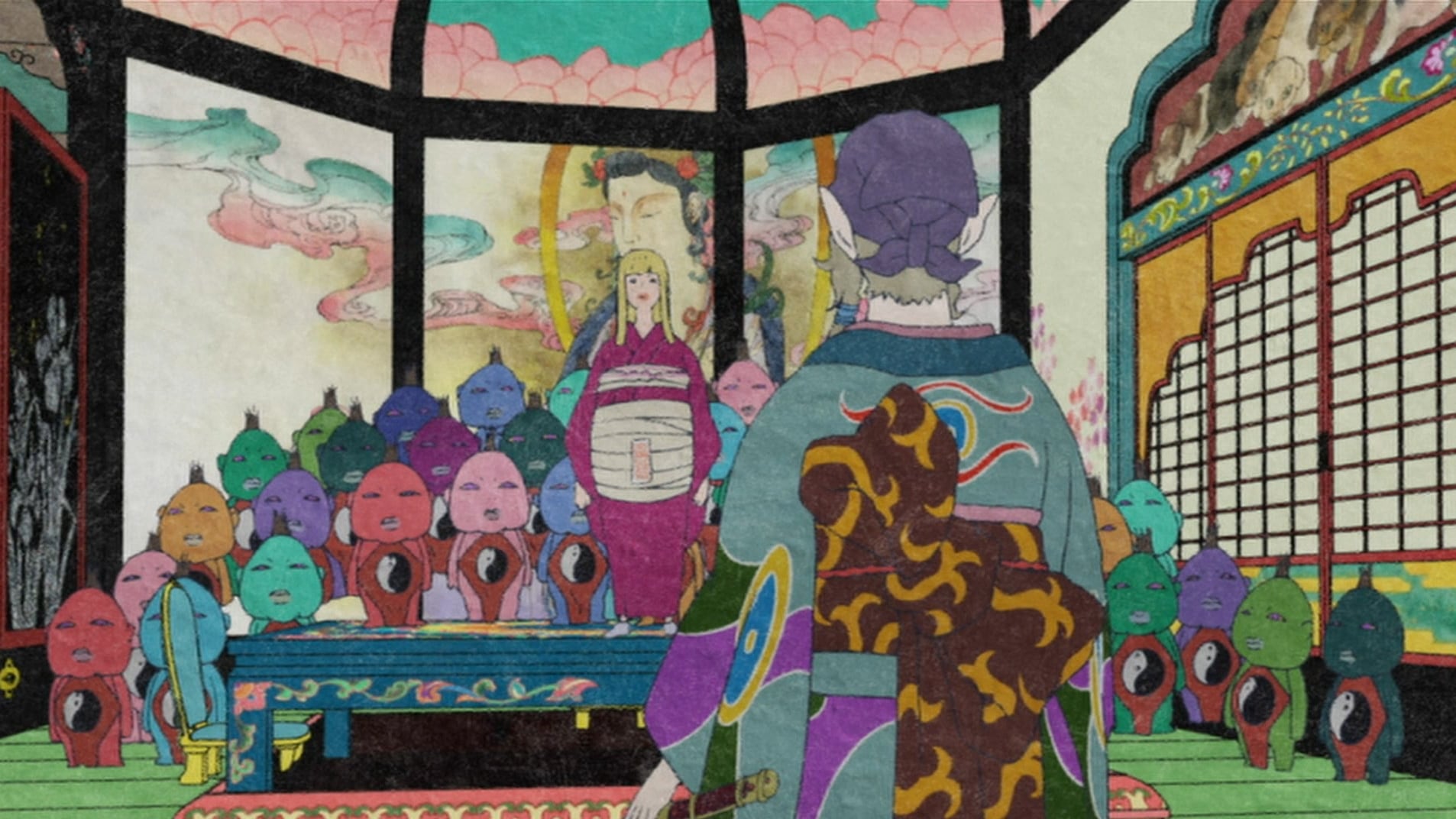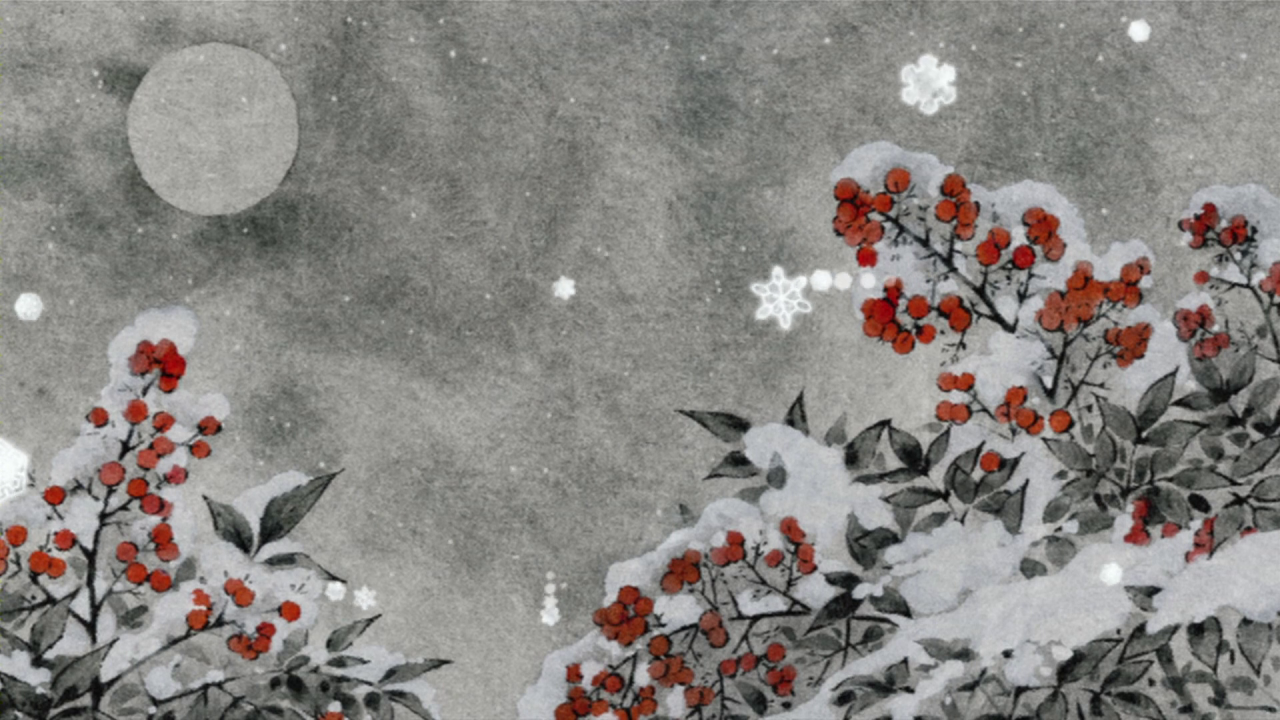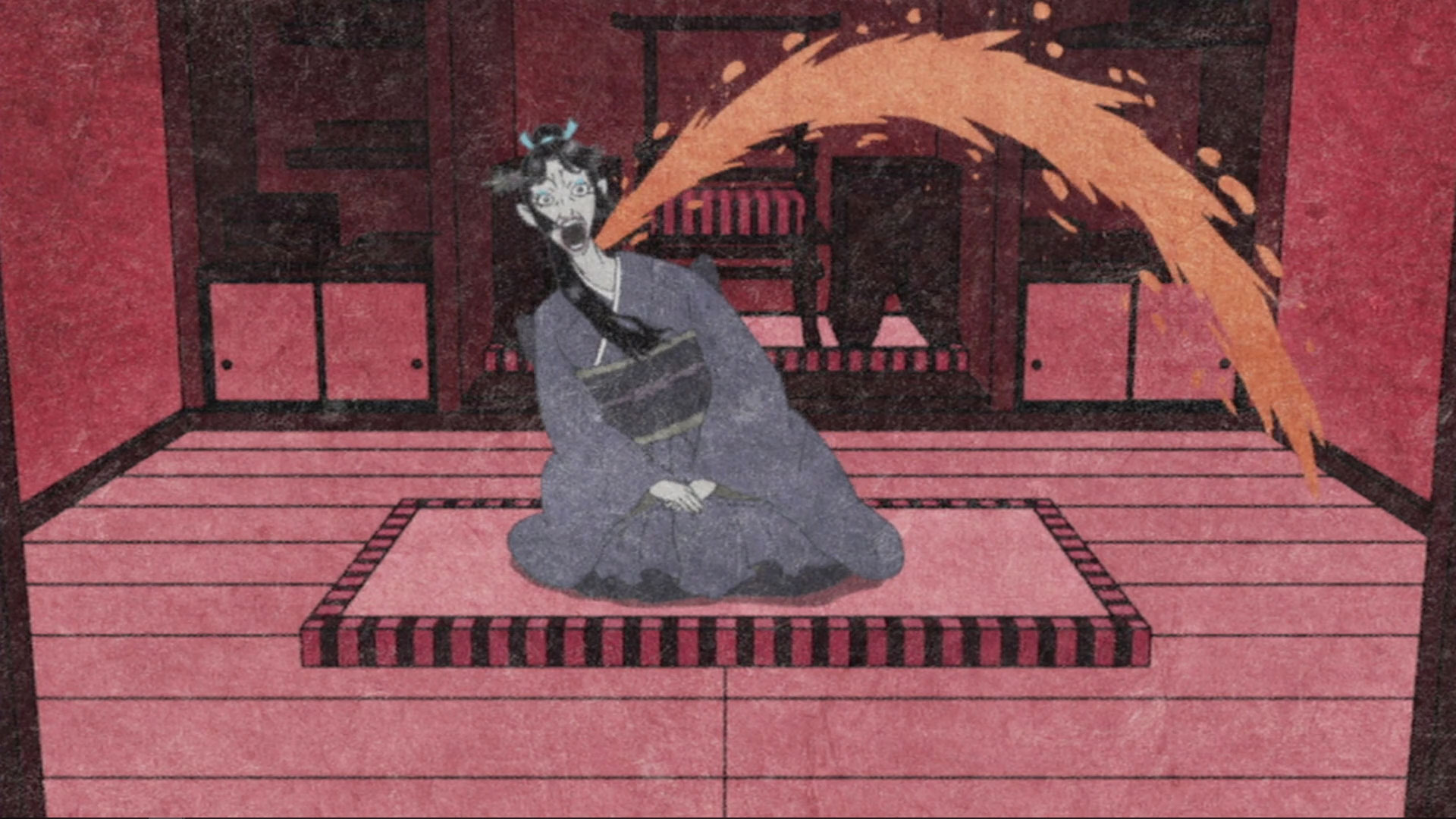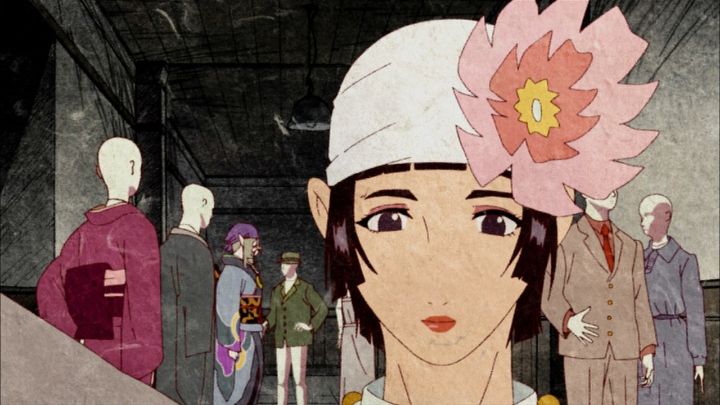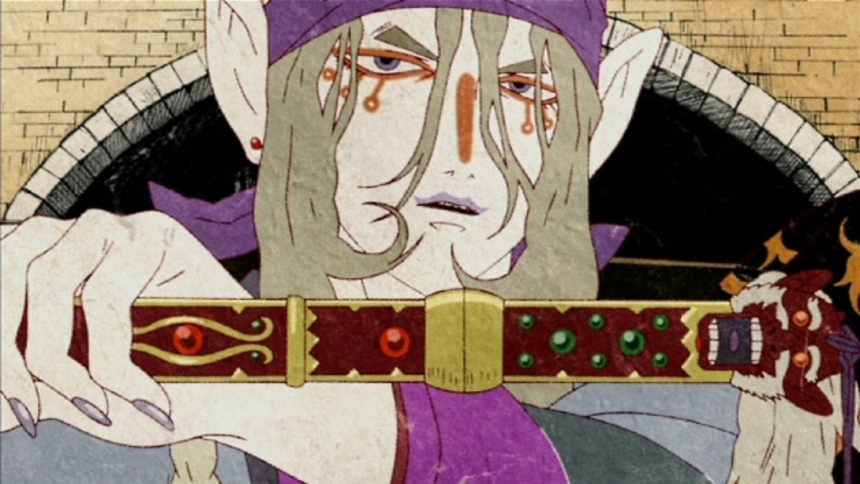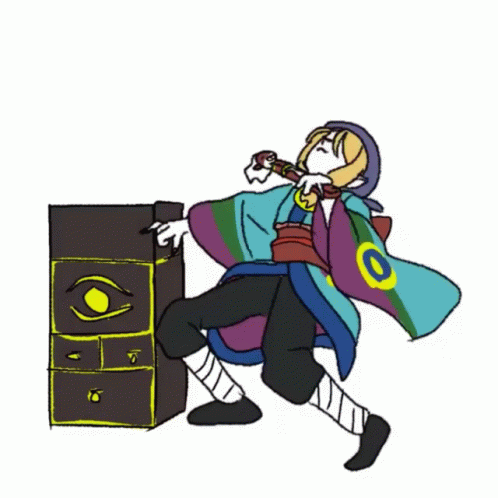モノノ怪
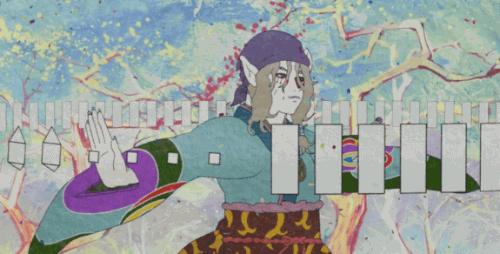
This page will contain spoilers and theories. Triggering content will be spoilered. Refer to the dictionary if you are confused about any terminology. Each arc's section will include a summary of the arc, the katachi, makoto, and kotowari, character name etymologies, my thoughts and theories about the arc, and a literature section which will have links to other people's theories and articles about the real life versions of things seen in the show. Also, I am a strong Kusuriuri x Kayo shipper, so my theories mainly revolve around Kayo's importance to Kusuriuri. Enjoy!
Synopsis
Mononoke is an episodic, avant garde 2007 anime that is a spin off of Ayakashi: Samurai Horror Tales / Japanese Classic Horror. The Bakeneko arc of Ayakashi should be watched before watching Mononoke since it serves as a prequel. A movie has been announced to premiere in 2023.
This short series spans multiple arcs where a simple medicine seller (Kusuriuri) solves mysteries of supernatural creatures that appear around Japan. His goal is to interrogate the involved parties and try to find the mysterious creature's katachi, makoto, and kotowari (shape, truth, and reason). The Monarch AMV by Iren S.S. makes for a great trailer for this anime, though it contains spoilers.
My thoughts
This anime is one of my major hyperfixations. I knew of this anime in my childhood through Nico Nico Douga meme videos, but I never actually remembered it to watch it until 10th grade. I absolutely adore the stories that are told in this anime, and the colours, animation, and use of CGI are mesmerizing. This series mainly speaks about women's issues which is unique to me, and I take Kusuriuri to be like a psychologist or psychiatrist.
This show doesn't go too far trying to be philosophical or deep, but there is a lot you can find within the show as it is meant to be interpretive. In addition to being based on Japanese folklore, it draws from Buddhist philosophy. Not only is the show beautifully animated, but it also utilizes art styles from Japan and from the West. There is symbolism everywhere you look, and despite having slow, mysterious pacing, the show is full of details that you will miss if you blink. Each watchthrough of the show is more enjoyable as you begin to understand more of it.
I love how the anime is so short with only 12 episodes, 15 if you count Bakeneko 1. The creators knew when to stop while the show was good, and they barely marketed it in the US most likely because it is such a niche show. The 2023 movie was made for the show's 15th anniversary after 15 years of little media releases and for director Kenji Nakamura's final work which shows how much love the creators have for this series. They never forced it to be more than it was, and they never made this show for a mass market audience.
I was also alive when Mononoke was put on Netflix with the never before seen English dub made like 12 years prior. I hate it. Please. I would rather take the Ayakashi Bakeneko English dub over this horror. "THEREFORE I NOW STATE CLEARLY"....
Bakeneko
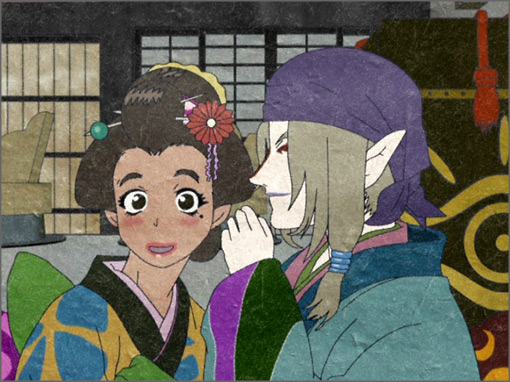
Summary
Kusuriuri enters the Sakai household. Kayo, a servant to the Sakai family, explains that Lady Mao is going to the Shiono household to be married. Kusuriuri tells her that he has a special remedy for newlyweds, and he shows her the items in his backpack. Kusuriuri thanks her for letting him in by trying to show her his shunga collection, but they are interrupted by a rat, to which Kusuriuri wonders why they have rat traps instead of just getting a cat. Kayo says that one of the household members can't stand cats. Sato, Kayo's boss, tells Kayo to return to work.
On the way to her wedding, Mao falls backwards and dies. The family members tie up Kusuriuri and search through his backpack, thinking he is suspicious. They find his drugs, tenbin, shunga, and taima sword. Servant Yahei is told to fetch the doctor, to which Kusuriuri warns him not to leave past the barrier of ofuda, but Yahei leaves anyway. The family members start to hear cats meowing, and Yahei's body is found dead. Kusuriuri senses the mononoke's presence and sticks ofuda to every wall. The ofuda turn red right near Clan Lord Yoshiyuki, father of Yoshikuni and Yoshiaki. When Kusuriuri finds black fur at the scene, he determines that the mononoke is a Bakeneko.
Kayo, home samurai Odajima, and Kusuriuri leave the protected area to obtain sake and salt. Kusuriuri makes a line of salt around the house for further protection. (Spoilers ahead) Kusuriuri lets Kayo handle the tenbin which bow to her, and he asks everyone again what the deal is with cats. Kayo says that Sato bought cats by home samurai Sasaoka's request. Yoshikuni boasts that he and Sasaoka killed about 20 cats in order to test the sharpness of his swords. House manager Katsuyama argues with the two men. The Bakeneko makes its way past the salt barrier when Mizue cries over Mao's body, and Mao turns into another living woman, Tamaki, as the Bakeneko reaches it. Mizue cries out, apologizing to Tamaki, and tries to pry open a sliding door while the Bakeneko is right at it. When she succeeds, the ofuda on the door burn up, and the Bakeneko makes its way in. Kayo throws the basin of salt into it, causing it to retreat. Yoshikuni opens a secret passageway that leads to a secret backroom where everyone will be safer.
Yoshiyuki says that he abducted Tamaki 25 years ago while she was being escorted to her wedding and held her captive in the secret room. He said that she stayed willingly, so Yoshiyuki gave her nice clothes and delicious food. As Kusuriuri fights to hold back the Bakeneko, Sato tries to kill Kayo, and Yoshiyuki tries to prevent Odajima from protecting Kayo. The taima unsheathes by itself, but Kusuriuri is overpowered by the Bakeneko which also kills Sato, Yoshikuni, and Yoshiyuki. The Bakeneko shows Kusuriuri, Kayo, and Odajima Tamaki's true story where she begged to go home. Yoshiyuki kept Tamaki in a cage and raped her along with Yoshikuni. Yoshiyuki abused Tamaki for being raped by Yoshikuni. The secret room was also the room that Yoshikuni and Sasaoka used to test swords. Sato brought food to Tamaki while she was in captivity, but Tamaki fed all of her food to one of the cats instead, hoping it will gain the strength to escape. While Tamaki was being hit, the cat defended her, and when she died, Sasaoka disposed her body. After seeing the full story, Kusuriuri exorcises the Bakeneko. Odajima leaves the household, and Kayo says she might go back to her parents. Tamaki and the cat's souls leave the household together.
Character name etymology
| Name | Meaning |
|---|---|
| Tamaki 珠生 |
珠 (tama): Jewel. 生 (ki): Pure. Tamaki can also be written as 玉木 "jeweled tree". The jeweled tree makes me think of the Jeweled Branch of Mount Hourai in Taketori Monogatari. Another interersting spelling of Tamaki is 環 meaning "ring", like the ring around the well in the igeta mon / Sakai family crest or the ring of walls that held Tamaki captive. |
| Kayo 加世 |
加 (ka): Addition. 世 (yo): World. I think this name refers to the positive influence that good people like Kayo have on the world. |
| Sakai 坂井 |
坂 (saka): Slope, hill. 井 (i): Well. The well is the most interesting part of the Sakai family name as it is present on the igeta mon / Sakai family crest, and Tamaki was disposed into a well when she died. |
| Mao 真央 |
真 (ma): Truth, reality, pure. 央 (o): Center. Mao's death led to Tamaki's truth being revealed. |
| Odajima 小田島 |
小 (o): Small. 田 (ta): Rice paddy. 島 (shima): Island, territory. |
| Sasaoka 笹岡 |
笹 (sasa): Bamboo grass. 岡 (oka): Hill. |
| Mizue 水江 |
水 (mizu): Water. 江 (e): Creek. The water part of her name seems to be related to the "well" part of the Sakai family name. |
| Yoshiaki 伊顕 |
伊: This character was used as a pronoun in China. I can't get much information about it including information about why it is pronounced as "yoshi". 顕 (aki): In China, this character means "manifest" or "evident". |
| Yoshikuni 伊國 |
國 (kuni): Land, country. |
| Yoshiyuki 伊行 |
行 (yuki): A place name. If pronounced "iku", it means "going" or "traveling" as he traveled before abducting Tamaki. |
| Katsuyama 勝山 |
勝 (katsu): To win. 山 (yama): Mountain. |
| Sato さと |
Sato can be written as 里 or 郷, and both mean "village". |
| Yahei 弥平 |
弥 (ya): To go across, wide. 平 (hei): Even, flat, calm. Well, he was calm in the few moments he appears, and he did cross the border between life and death when he attempted to find a doctor. |
My thoughts
This is definitely the gnarliest arc of the whole series. Though the art is not as polished and beautiful as in Mononoke, the story is the best and the most straightforward. Bear with me for the rest of my review because the only versions of Bakeneko 1 I have access to are the Japanese audio with Viet subtitles and the English dub. I don't have the English subbed version anymore.
Okay first, I just think it is Very interesting how one of the characters says that rats are a sign of fertility, and a rat interrupts Kayo and Kusuriuri's flirting right before Kusuriuri starts to show her his shunga. Plus, Kusuriuri himself symbolizes fertility as an Inari kitsune. The way Kusuriuri and Kayo flirt with one another is like nothing else in the Mononoke series. Kusuriuri's tone of voice towards Kayo is obviously flirtatious, and in general, he shows more emotion outwardly in this arc than in Mononoke. He showed affection towards Kayo, playfulness towards Odajima, and disgust towards the crimes done to Tamaki. This is in contrast to his more reserved nature in Mononoke. This could be because in Bakeneko 1, he was younger and not as experienced as he became in Mononoke. I actually have a theory that this was his first time exorcising a mononoke, and it was his first time being exposed to human evil.
In Bakeneko 1, Kusuriuri used his own raw power, his own hand, to push back the Bakeneko, causing himself to bleed. This is not seen at all in Mononoke except in one Bakeneko 2 scene, likely because Kusuriuri learned to use the powers of the ofuda, tenbin, and taima alone. Another person noticed that the way Kusuriuri uses ofuda changed from Bakeneko 1 to Mononoke which also illustrates the progression of his experience. In Bakeneko 1, Kusuriuri placed ofuda haphazardly on every wall in the house. In Zashiki Warashi, he only placed them in strategic areas, and he used a single ofuda on Shino to protect her unborn child. In Umibozu, he only used ofuda once when it was needed, and the same applied to Nopperabou and Nue. In Bakeneko 2, he showed the most controlled and organized use of ofuda.
Apparently, in the English subbed version of this arc, Kusuriuri says that he is "not an interesting human". This is taken by some fans as evidence to suggest that Kusuriuri is not human. In the original Japanese dialogue, the Viet subs, and the English dub, this line doesn't actually mean Kusuriuri denies being a human. Like.... he doesn't actually say "I'm not an interesting human", he says "I'm an uninteresting person", "tsumaranai ningen". His nonhumanness is better attributed to the other obvious signs like the fact that he has pointed ears and lives for hundreds of years.
I definitely believe that Kusuriuri is an ayakashi, and I might believe he is a mononoke. I think if he was a mononoke, he became one because of Kayo. Why? I think the strong human emotion would be love or grievance over love that cannot be the feeling of wanting to protect good people from suffering with mononoke. Tamaki was a decent person who suffered needlessly and caused the creation of a mononoke. After seeing the truth about Tamaki, he might have felt enough disdain towards oppression, especially of women, that he became a mononoke whose destiny is to slay mononoke until he dies. Seeing as Kayo was a good person that he loved, he stayed away from her after this arc to prevent a mononoke from forming out of her feelings towards him.
Katachi: The Bakeneko was formed from Tamaki's emotions and the cat's emotions in the Sakai household.
Makoto: Tamaki was held captive and raped by Yoshiyuki, and Yoshikuni and Sasaoka used cats to test the sharpness of their swords.
Kotowari: Tamaki and the cat protected each other to no avail with Tamaki feeding the cat and the cat standing in the way of Yoshiyuki when he abused Tamaki.
Zashiki Warashi
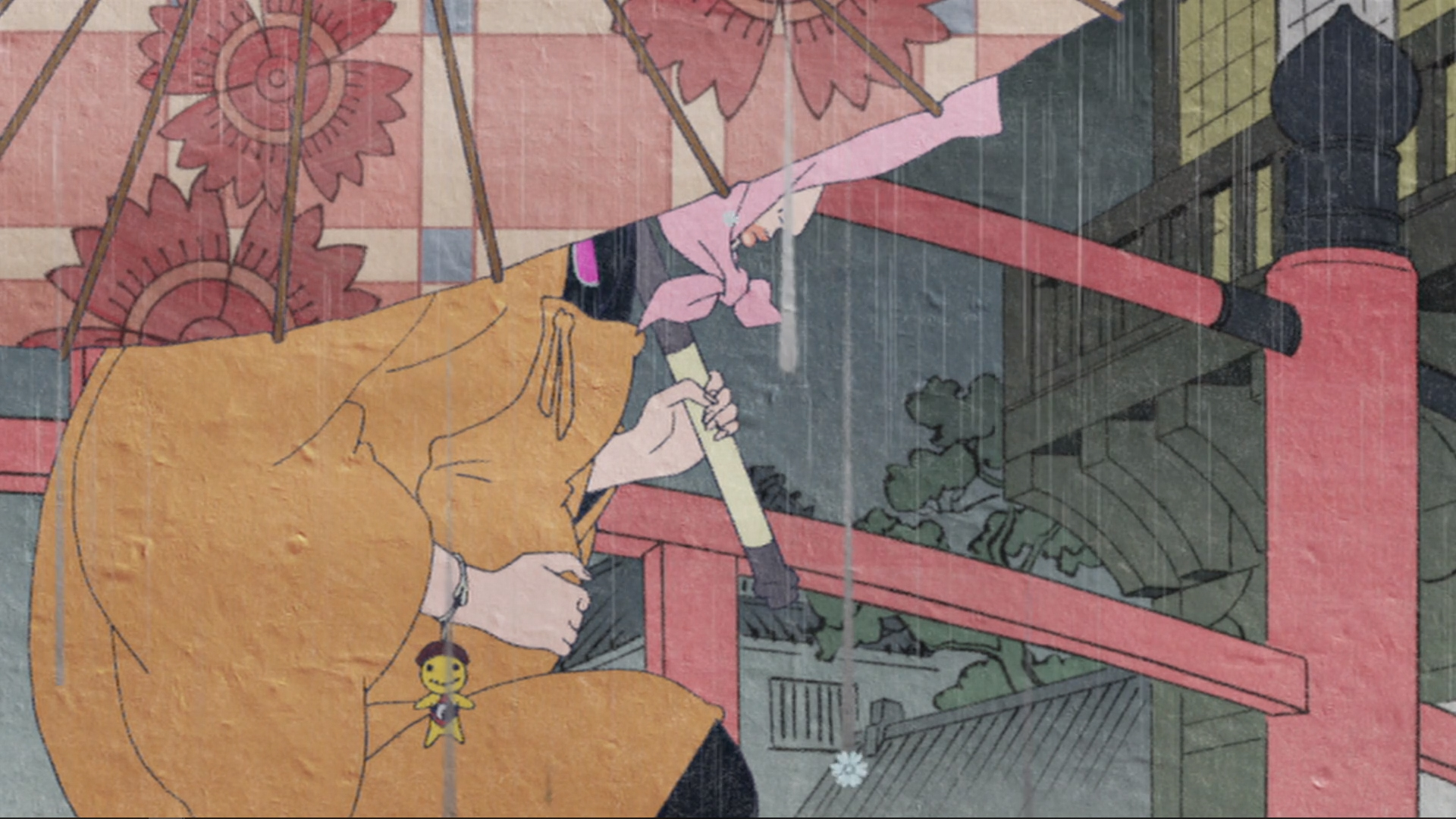
Summary
Kusuriuri books a room at an inn owned by Hisayo, a woman who has tended to the inn since she was young. Tokuji is an employee at the inn. Shino, a pregnant woman, asks for a room because she has run away from a person who is going to kill her, but Hisayo refuses because Kusuriuri booked the last room. Eventually, Hisayo agrees to let Shino stay in the uppermost room that is normally closed. On the way up the stairs to the room, Shino hears the sound of children laughing and complains about a stench. In the room, Shino finds an anzan daruma doll resembling a baby, and an odd child, a Zashiki Warashi, tells her to give it back. The child disappears, and baby dolls appear around the room. In the middle of the night, Shino wakes up to find Naosuke, the assassin, standing over her and demanding her not to give birth to the child because it would be inconvenient to her master and mistress. The assassin attemps to slash Shino with his sword, but he gets hung and spun around from the ceiling by the power of the Zashiki Warashi to protect Shino and her unborn child. Shino points out the sounds of children playing, but no one else hears them.
(Spoilers ahead) The Zashiki Warashi transports Shino to a past version of the room where it continues to stink. She sees two people having sex while a red ribbon stretches from their bed to a baby doll. Sections of the walls start sliding out like drawers, revealing baby dolls in them that represent aborted fetuses. Hisayo then tells Kusuriuri that the inn used to be a brothel, and Shino's room used to be an abortion room that the owner said was a favor for the sex workers. Shino has visions of her memories with her master including her master's marriage proposal. After she tells him that she is pregnant with his child, he assumes that Shino is just a gold digger. Shino hears some Zashiki Warashi calling her mother, and a red ribbon with a baby doll appears attached to Shino and her master's bed.
In a flashback, Hisayo, as a younger woman, pulls out and tears apart the red ribbons coming out of the sex workers. A younger Tokuji is also an accomplice. He tells Shino that they can help her get rid of the Zashiki Warashi by aborting her unborn child, and Shino has a vision of Hisayo pounding her fists on Shino's torso. In reality, the Zashiki Warashi drown Hisayo and Tokuji with ribbons, and Shino offers to give birth to the Zashiki Warashi, tearing off the ofuda that Kusuriuri placed on her abdomen. This causes the baby doll attached to Shino's red ribbon to crack, and her unborn baby thanks her for the love she gave and apologizes for causing her pain. Shino apologizes to the Zashiki Warashi for not being able to give birth to them, as she still wanted her own child to survive and decided not to birth the Zashiki Warashi. The Zashiki Warashi allowed themselves to be exorcised since they understood that Shino loved them, and they extended compassion to her by allowing her own child to be born instead. Kusuriuri exorcises the Zashiki Warashi, causing Shino's child to not be harmed in the end.
Character name etymology
| Name | Meaning |
|---|---|
| Shino 志乃 |
志 (shi): Purpose, will. 乃 (no): From, you. As DharmaFox stated in their analysis, the will is the will to give birth to her son and to the Zashiki Warashi and the will to reach enlightenment for the sake of all beings. The "no" part of her name could reference nonduality and oneness. |
| Hisayo 久代 |
久 (hisa): Long time. 代 (yo): Society, age, era of rule. This name references her age, obviously, and the way she ruled over the sex workers' bodies when she ran the brothel. The reference to society in her name could represent how groups of people in society want to legislate over women's bodies like the way men write laws governing abortion. |
| Tokuji 徳次 |
徳 (toku): Benevolence, virtue. 次 (ji): Secondary, following. After studying his name, I want to talk about him more here. As a Black man in Japan in the only area open to foreigners, it is difficult for him to make a living. It's likely that he has no choice but to follow the orders of Hisayo. His ancestors might have been considered burakumin since he worked in a brothel and helped Hisayo abort fetuses, a job that Japanese people in power wouldn't dare to do. If he was not of an oppressed class and taken advantage of by Hisayo, he might have been benevolent. This is a subtle representation in the show of intersectionality, how a woman can still have advantages over a man when we consider factors like race. |
My thoughts
I think this arc takes place in Dejima, and this can be explained by / explains several things. Half of the cast in this arc are foreigners, and Dejima was the only place open to Western foreigners in the Edo period. Shino is very white which might suggest that she is Dutch, the only Westerners that were allowed to trade with Japan after the Portuguese. The doors to the inn are on hinges which is unlike a regular Japanese door at the time, further suggesting that it is in a location open to Westerners. An Edo period ground plan of Dejima shows it connected to the mainland with a bridge, and we see Kusuriuri entering the scene on a bridge. The bridge could also represent Kusuriuri entering an area where spirits dwell, and another bridge is seen within the inn on the way to the upper room.
The paintings of women on the walls in this arc remind me of the works of Utamaro.
I like the use of red ribbons to represent umbilical cords and the way baby dolls were used in place of fetuses. This allowed the writers to tell a gruesome story without explicitly drawing those things as this is one of the most taboo subjects I have seen represented in anime. The use of Kannon / Guan Yin / Quan Am / Avalokiteshvara, the boddhisattva (haha) of compassion is fitting as Shino showed compassion towards the Zashiki Warashi and vice versa.
On the other hand, Hisayo was represented by Kannon in a different way. Kaigou's analysis of Bakeneko 1 included backgrounds behind characters that told us something about them. In Zashiki Warashi, there is one scene where the wall painting of Kannon can be seen behind Hisayo. The painting has a blood red overlay on it, and the frame of the wall severs Kannon's hand, indicating that Hisayo has no compassion. She also stretched her ears with heavy earrings after her youth. This makes me think she wanted fuller lobes to make herself look virtuous and hide her sins as full lobes are associated with the Buddha, Kannon, other boddhisattvas, compassion, wisdom, wealth, and luck. Unfortunately for her, she didn't hide her oiran kanzashi which caught Kusuriuri's eye at the beginning of the arc.
I'm not digging the antiBlack caricature in this arc. The way they drew big lips in this show is questionable, especially for Black characters like Kayo and Tokuji. Even Shino in this arc and Oyou in Umibozu had strangely stylized lips as white and Asian women. I can only hope that the 2023 movie improves on this as it is the only major complaint I have about the show.
Going back to this arc in particular, I take it to be prochoice as the sex workers did not consent to the abortions. The innkeeper took advantage of those women in debt. If the intention of this arc was to be antichoice, I think they would not write it in a way where the abortions were nonconsensual, and they would specifically villainize people for choosing abortions for themselves. As the story is written, the villain is the person who made decisions for people's bodies without consent.
In this episode, as Kusuriuri learned about Shino's unacceptable relationship with her master, I think Kusuriuri realized that there will be consequences if he were to have a relationship with any human, including Kayo. This would further convince him to keep his distance from Kayo. I will elaborate on that in the Umibozu section.
Katachi: The Zashiki Warashi were formed from the emotions of fetuses aborted in the brothel.
Makoto: The Zashiki Warashi wanted to be born, so they chose Shino to be their mother.
Kotowari: The Zashiki Warashi were going to use Shino and take Shino's child's potential life to be born themselves, so when Shino showed selflessness by offering to give birth to them, they regretted wanting to take Shino's child as their lives were also taken from them.
Umibozu

Summary
Merchant Mikuniya Tamon owns the Sorarisu ship used to bring goods from the West into Edo which is full of goldfish. He travels to Edo with Kusuriuri, minstrel Yanagi Genyousai, Kayo, samurai Sasaki Hyouei, monk Genkei, and Genkei's disciple, Sougen. Goromaru works on the ship, but he disappears by the end of the arc. Hyouei asks Kusuriuri if he can unsheathe his sword. That night, Genkei and Sougen have sex while reciting the Heart Sutra, and the ship's compass moves away from north, causing the ship to go off track into the Dragon's Triangle which is full of ayakashi. Kusuriuri discovers that a magnet hidden under the compass was used to redirect the ship. The compass spins out of control, trapping the ship in the sea, and Kusuriuri gets Kayo's help to set up some tenbin. Hyouei once again expresses interest in Kusuriuri's taima. When dead fish surround the ship, Kusuriuri says that they want the passengers to join them. The passengers make a line of ashes instead of salt around the ship, but the dead fish can go right through because the wood ash was contaminated with burnt rope. The dead fish lift up the entire ship, and Kusuriuri makes a light bomb that blows up the dead fish, saying that light doesn't only come from the sky to dispel darkness.
(Spoilers ahead) Kayo suspects every passenger of having reasons to redirect the ship, including Kusuriuri who evil laughs wondering what ayakashi will appear next. When Kayo starts making faces at him, he wonders how she will ever marry. Kayo scolds him about acting overly mysterious. When the passengers discuss the definitions of ayakashi and mononoke, Hyouei wonders about the taima again. Kusuriuri ignores Kayo's question about whether there are mononoke present there. The Umizatou arrives to ask each passenger what their greatest fear is. Genyousai offers suggestions of workaround answers that will "trick" the Umizatou. However, no matter what the answer is, each person hallucinates their worst fear.
Tamon says his worst fear is losing all his money, and he sees all his goldfish coming out of his mouth dead. Hyouei says he fears nothing, and he sees all the people he has killed combined into one monster that swallows him. Kayo says she fears not being able to marry and have children, and she sees herself giving birth to a fish creature that has some of Kusuriuri's traits which causes her to fall backwards. Kusuriuri catches her before she hits the floor, and he comforts her, telling her it's just a bad dream. Genyousai says he fears manju, and he is seen enjoying a manju until he vomits at the mystery ingredient inside. Kusuriuri says he fears that the edge of the world exists without katachi, makoto, or kotowari, and he sees himself disappearing. Sougen says that he fears Genkei the most. He says that after they had sex, Genkei expressed disappointment with Sougen, so Sougen left to cry. This means that only Genkei was alone and unaccounted for to redirect the ship. Genkei admits to doing it, and the Umizatou asks him what his worst fear is. He answers that for fifty years, an utsurobune containing his sister, Oyou, had been floating in the sea and attracting ayakashi to it. Satisfied with the answer, the Umizatou leaves.
An eye opens above the sea, and chains rain down to lift up the utsurobune from the water. Genyousai hears scratching from within the utsurobune and suggests that they open it to give Genkei's sister a real funeral to rest her soul. The passengers struggle to open it, and at Kayo's insistence, Kusuriuri uses ofuda to open it and find it empty, proving that Oyou did not become a mononoke. The ofuda turn red, and the tenbin's bells drop as it lands on Genkei's hands. The passengers, with the exception of Hyouei, get in an intervention circle with Genkei in the centre. Genkei said that he and Oyou were affectionate as children, and he joined the monastery at age 15 as it was the tradition of their island. He left the island to undergo purity training which he failed at because he still thought about Oyou and feared that she would marry someone else. At that time, many ships were sinking at the Dragon's Triangle, and his island's inhabitants wanted him to sacrifice himself to the utsurobune. Genkei reunited with Oyou before the sacrifice was to be done, and he became afraid of sacrificing himself. She suggested that she take his place because she would rather die unmarried than live not married to Genkei. He should have joined her, but he ran away, and he was glad that she took his place because it meant that he could live and complete his training. His past sins caused him to fear that Oyou would want revenge. After Genkei reveals this, Kusuriuri exorcises the Umibozu. Hyouei seems to inherit the Umibozu and says "I will never forget you".
Character name etymology
Please see DharmaFox's analysis "On “Umi Bozu” and an allegorical reading of Mononoke".
My thoughts
This arc was the one that puzzled me for the longest time. I'm surprised that people found Nopperabou more difficult than this one. I think I finally have a tighter grasp on this arc after watching it to write this summary. Something that still puzzles me though is how a Klimt painting (counterfeit Der Kuss and Water Nymphs) exists on the boat when Klimt was born in 1862 and the Edo era ended in 1868. There are other anachronisms in the show though, and what's with the Sakai family crest / igeta mon on Genyousai's fan?
Something that does make some sort of sense though is how in the Edo period, Japan only traded with the Dutch at the Dejima Dutch trading post, so the Sorarisu ship is likely used for trading with the Dutch. If we assume the characters were traveling from Dejima, where the Zashiki Warashi arc occurred, to Edo, their path would wrap around the bottom of Japan very close to the Dragon's Triangle in real life, so the geography makes sense.
I am absolutely a freako who believes that Sasaki Hyouei is Oyou, but for fun. They have long black hair and thick lips, and Hyouei's clothes look like they could be blood soaked the same colour as the interior of the utsurobune. He was also the only character to be on the surface of the ship while Genkei was telling his story of him and Oyou, and Hyouei appeared there right before Oyou made her first appearance. What ended up happening to this new mononoke in Hyouei? I wonder if Kusuriuri was ever sent back to take care of it. I think it's funny how there isn't any resolution after Genkei becomes young, like they all still had to travel the rest of the way to Edo after the incident. My friends and I believe that Kusuriuri and Kayo did it on the ghost ship after the events of this arc.
In this arc, there are a couple of shots where Kusuriuri is seemingly the only one who sees some ayakashi. I think this is evidence that supports the theory that Kusuriuri is an Ayakashi. His job is to hunt down mononoke, not ayakashi, so he leaves the ayakashi alone. The part where Kusuriuri ignores Kayo's question could be used as evidence that Kusuriuri is a mononoke, and he didn't want to tell the true answer. The tenbin also fell at this scene when only Kayo is around. Usually the tenbin only tilt, and I don't know what would be strong enough other than Kusuriuri himself to make tenbin fall completely as they've only fallen a few times in the show. It could be Kusuriuri's way of showing her, one one person he trusts or cares about, that he is an ayakashi / mononoke. If Kusuriuri has any control over the tenbin, maybe he made them bow to Kayo and Chiyo as a form of alternative and augmentative communication.
"Kusuriuri doesn't care about anyone" my bottom. He didn't need Kayo to handle the tenbin, but he let her do it anyway because he knows she likes them. He didn't have to catch Kayo or comfort her, but he did. He even flirted with Kayo a bit in a more restrained way, but again, he didn't have to. He cares. It's sad that he has to restrain himself to be "professional" and to not cause the creation of a mononoke, but he shows in his own subtle ways that he hasn't lost the feelings he had in Bakeneko 1. I wonder if him evil laughing was an act to keep a distance from Kayo or drive her a bit away from him.
Remember when Kusuriuri teased Odajima and made fun of him? He did the same with Genyousai, but of course, he held back. When Genyousai was heckling Kusuriuri about the bomb, he told Genyousai to chant or use whatever wizard powers he had just to shut him up. Speaking of Genyousai, he is quite an interesting foil to Kusuriuri.
| Kusuriuri | Genyousai |
|---|---|
| Deep knowledge about mononoke | Surface level knowledge |
| Real supernatural powers | Can only chant hymns |
| Talks only when necessary | Talks too much / mansplains |
| Lipstick on top lip | Lipstick on bottom lip |
The idea that Kusuriuri fears not having to exist anymore based on the way he answered his worst fear is a spot on interpretation. If we assume that Kusuriuri is a mononoke, and his regret is that he cannot have relationships or indulge in human emotions as the near-immortal slayer of mononoke, he himself won't need to be exorcised because the lack of all other mononoke makes his regret "null" if that makes any sense. Like his feelings of regret would be relieved if there were no more mononoke to slay. Also, the only way there could be a complete lack of mononoke is if there is a complete lack of humans or sentient beings capable of understanding human emotions. Without any of them, it'd be impossible to exorcise Kusuriuri, so he would just disappear.
This show has samsara and rebirth as major themes. Mononoke cannot exist without people, and people cannot exist without forming mononoke or without the extermination of mononoke by Kusuriuri. The only way for mononoke to disappear completely is for humans and sentient beings to disappear completely. This is precicely the first Noble Truth in Buddhism, the fact that suffering is inherent to life. In this arc, Kusuriuri can be seen resting in a position that is a reflected reclining Buddha position that the Buddha took when he reached parinirvana. This shows that rather than dying and moving towards parinirvana, Kusuriuri is continuing to live for hundreds of years and remaining in samsara to slay mononoke and help good people live. This agrees with DharmaFox's theory that Kusuriuri is a reincarnation of Manjushri, the bodhisattva of wisdom.
Katachi: The Umibozu was formed from Genkei's emotions towards his sister, Oyou.
Makoto: Genkei didn't love Oyou as much as she loved him, and he was happy that she took his place so that he wouldn't have to die in the utsurobune.
Kotowari: Genkei feared his past impurity and selfishness, and his guilt caused him to fear that Oyou's soul was suffering or wanting revenge all that time, but in reality, Oyou had already become one with the sea.
Nopperabou

Summary
Satsuki Kazuma and his entire family were murdered by his wife, Ochou, who goes to jail with a death sentence for her crime. Kusuriuri claims to be a prisoner because he fought with a customer who complained about the medicine be bought having no effect. He states that the effectiveness of a medicine is also coupled with the belief that it is effective. Kusuriuri interrogates Ochou in her cell, describing her crime as hanging four people from a plum tree. Ochou denies that the crime happened that way, saying that she forgot how it happened. There were no witnesses or evidence of the crime, only Ochou's admission of guilt.
A man in a fox mask appears. He fights with Kusuriuri and uses his powers to remove Kusuriuri's face. (Spoilers ahead) The fox mask man tells Ouchou that he was a mononoke born to free her. Ochou has a flashback to living with her abusive inlaws who mention Satsuki's first wife who hung herself. The fox mask man asks Ochou to marry him. At their wedding, styled like a Noh play, Ochou says that the guests, who are composed of dancing humans and floating masks, are nice. The fox mask man tells her that they have always been around her, and people often forget who they have met and how many people have helped them. Ochou's mother appears to congratulate the new couple and thank them for giving her a reason to have pride when she visits her Umezawake clan ancestors' graves.
Ochou has a flashback to her childhood where her mother trains her to play the koto and tells her to maintain her beauty to marry into a wealthy family as a child from a humble upbringing. In the real world, Kusuriuri returns with a new face that he reverts back to his old one at will. He fights with the fox mask man again and uses his medallion to reflect the fox mask man's powers back to himself, causing the false environment around them to fall. Kusuriuri builds a new theatre with his ofuda that show Ochou's abusive inlaws and how Ochou watched the sky from the barred window of Satsuki's house as if she was living in a prison. Ochou has a flashback to her childhood where her mother scolds her for playing the koto wrong. In a flashback to Ochou's first wedding, Ochou's mother congratulates and thanks Satsuki's family, even begging them to keep Ochou in their family. In both flashbacks, Ochou's soul leaves her body and disappears.
Back at Satsuki's house, the fox mask man is revealed to be the one who handed Ochou the knife used to kill. When Kusuriuri psychoanalyzes Ochou's life, she cries about how her mother never listened to her. Kusuriuri asks Ochou once again who she killed, and he reveals to Ochou using his mirror medallion that she killed her own soul, and she was the Mononoke, a Nopperabou. She asks him why the Nopperabou ended up saving her in the end in the form of the fox mask man, and Kusuriuri tells her that the mononoke fell in love with her. Kusuriuri exorcises the mononoke, and Ochou leaves Satsuki's house.
Character name etymology
| Name | Meaning |
|---|---|
| Ochou お蝶 |
蝶 (chou): Butterfly. An animal with wings, like the bird. Ironic considering how Ochou refused to fly from her in laws' house. Her name also reflects Kusuriuri's butterfly imagery. She might be a character that represents how Kusuriuri had to virtually become a Nopperabou to do his job after Bakeneko 1 as he couldn't risk showing unnecessary emotion or forming relationships with humans. |
My thoughts
I don't see many references to specific artists in this arc, except the outside backgrounds in flashbacks could be references to Hokusai like the outside backgrounds in Bakeneko 1. I love the idea that since Ochou was raised to understand forms of high art like playing the Koto and understanding Noh theatre, Kusuriuri used Noh theatre to help Ochou come to terms with her trauma.
In the flashbacks to Ochou's childhood, there are temari balls on the walls, and she is seen playing with them. Temari balls are pieces of art in the Japanese upper class, and they are often gifted to children by their parents. Mothers put secret wishes for their children into the balls. This symbolizes the many expectations that Ochou's mother had of her.
I've seen some theories that Kusuriuri confesses his love to Ochou at the end, but I believe that the mononoke he described was not him, it was Ochou, the Nopperabou, having enough self love to leave the abusive household. When Kusuriuri tells her that the mononoke fell in love with her and added "his love could never be; the mononoke despaired / A hopeless love; what a pitiful mononoke", this phrase in Japanese did not include gendered pronouns, so "his" actually refers to Ochou as the Nopperabou initially not loving herself.
I think he was also alluding to his own relationship with Kayo as that comment was worded strangely as if it was not about Ochou's situation alone. He saved Kayo when she hallucinated and fell backwards in Umibozu because he loved her. After seeing the consequences of forbidden relationships in the Zashiki Warashi arc, he knew that he couldn't interact with Kayo as intimately as he had in Bakeneko 1. It could also mean that, at the time of Nopperabou, Kayo was living another life far away, or she was no longer alive.
That would play into the theme of freedom. Ochou was freeing herself from her inlaws, and with Kayo dead or at a safe distance, Kusuriuri could free himself from strong human emotions like love as I briefly mentioned with Ochou's name etymology. I think Kusuriuri was grieving in this scene.
Katachi: The Nopperabou was formed from Ochou's emotions towards her mother since her childhood.
Makoto: The mononoke controlled the fox mask man and deceived Ochou into thinking she couldn't escape from her situations.
Kotowari: Ochou was raised to believe that her life purpose was to marry into a wealthy family, and she killed her own soul to fulfil her mother's wish, turning herself into the Nopperabou.
Nue
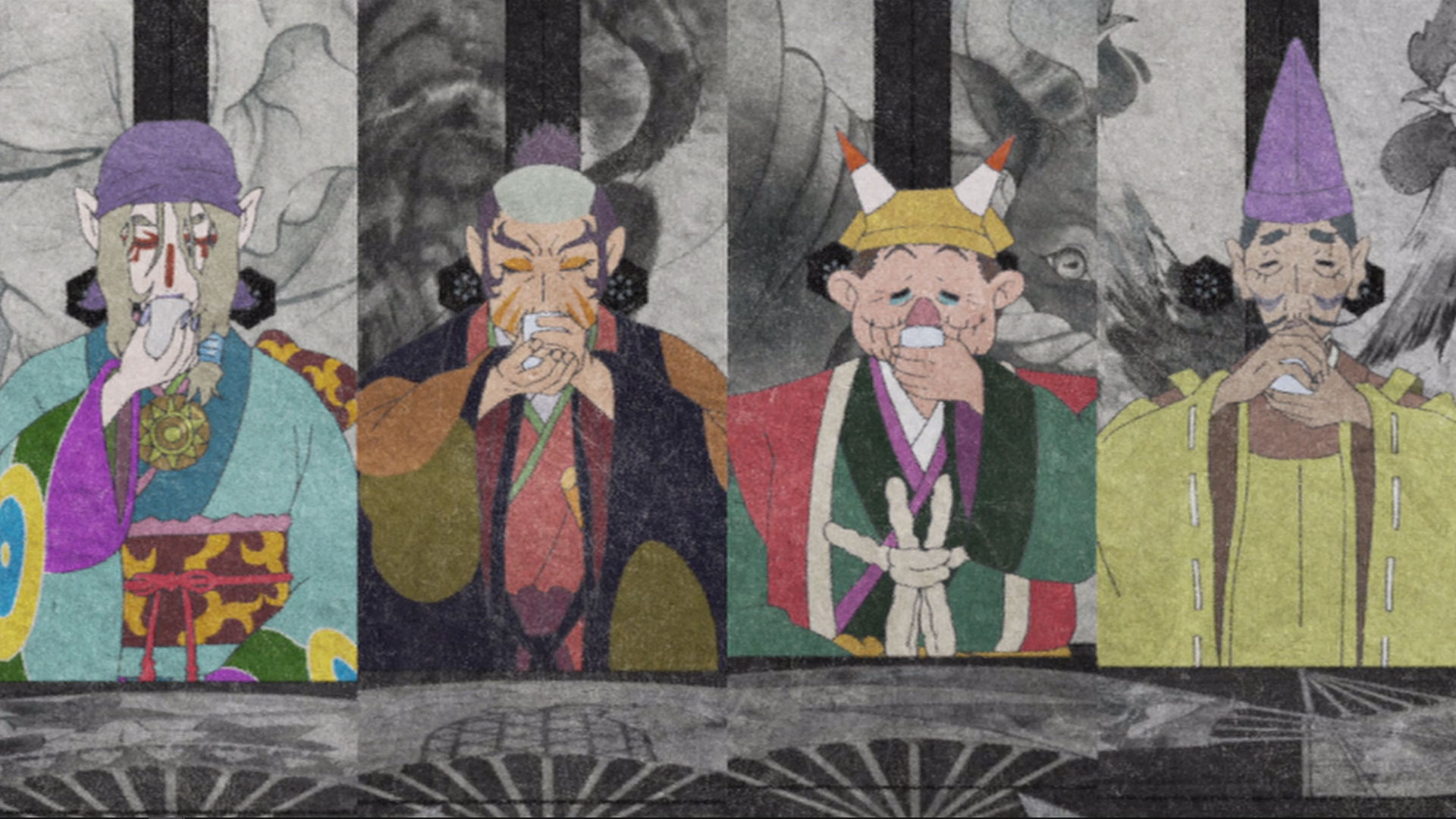
Summary
On a snowy day, three suitors compete in incense games called Kumikou to win the heart of Ruri Hime, the only person to practice a particular style of incense and the only heir to the Fuenokouji school of incense. Muromachi is a samurai from Azuma. Nakarai is a widower who runs a fishery. Oosawa is a member of the imperial court. Because the fourth suitor, Jissonji, is missing, Kusuriuri takes his place. An old woman takes the men into the game room, and Ruri prepares each incense sample for the game. Each scent reminds the players of memories from their lives, but Muromachi thinks they all smell the same, like horse dung. When the players submit their final answers, they go into recess.
During recess, the players separate to different areas of the school to find something. Nakarai sees a dog, Oosawa sees the old woman, and Muromachi sees a little girl. When they return to the game room, Kusuriuri has already set up tenbin. He places ofuda on the walls, and they react, indicating the presence of a mononoke. (Spoilers ahead) When he opens the door, he finds the body of Jissonji with blood splattered all over the walls. When he opens the next door, Ruri dies, and the men scramble to find the Toudaiji, a piece of wood that is hidden in the school. The old woman comes to ask about the commotion, but the men prevent her from discovering what happened.
The men admit to Kusuriuri that they never wanted to marry Ruri because of love, and they didn't want to take control of the school of incense either; they only wanted the Toudaiji because it was said to grant power to whoever held it. They discover that the answer to the kumikou does not match with any of the answers they chose, so none of them won. They decide to hold a rematch, playing Taketori no Kou with Kusuriuri as a referee to decide who gets the Toudaiji. As the players begin to smell the first incense samples, Kusuriuri tells them that he accidentally mixed a poisonous oleander into one of the incense samples.
One by one, the men die after they smell their incense samples and their crimes are revealed. Muromachi smells blood from a screen door. The missing suitor, Jissonji, was killed by Muromachi with his sword after Jissonji trash talked him, and his blood was splattered all over the screens. Narakai smells burning hair. Nakarai stabbed and killed Ruri when he saw her masturbating and kissing a painting of another man. Though Oosawa never committed any crime, he thought that his incense sample contained the oleander as the other men did not die from oleander poisoning, so he died by falling and breaking his neck as he panicked to find an antidote. Kusuriuri reveals that a simple medicine seller like him wouldn't be able to afford oleander.
In reality, the men were already dead, and he only needed them to realize that. The men were made to play endless incense games by the mononoke. Kusuriuri declared the mononoke to be a Nue formed by the Toudaiji's desire to be valued. Kusuriuri then destroys the Toudaiji using the taima's flame and releases its true scent into the entire town which is revealed to be in abandoned ruins.
Character name etymology
| Name | Meaning |
|---|---|
| Nakarai Tansui 半井 淡澄 |
半 (naka): Half. 井: Well. 淡 (tan): Diluted, pale. 澄 (su): Purify, clear, precipitate. This character's name references the diluted ink required for sumi-e paintings. The dilution and half could also refer to the fact that the men are ghosts, not fully living humans. There's also the well again from Bakeneko 1. |
| Oosawa Roubou 大澤 廬房 |
大 (oo): Great. 澤 (sawa): Swamp. 廬 (ro): Temporary lodging. 房 (bo): Chamber, home of a monk. I'm not sure of what his name means. The temporary lodging could reference the fact that the men were trapped in the school to play kumikou forever until Kusuriuri stepped in. The chamber or home of a monk could reference the Todaiji Temple where the Ranjatai is kept. |
| Muromachi Tomoyoshi 室町 具慶 |
室 (muro): Cellar. 町 (machi): Town. Muromachi district in Kyoto, in Kansai region where Osaka and the Todaiji Temple in Nara are. 具: Tool. 慶: Jubilation. During the Muromachi period, the Japanese capital was in Kyoto, and there was the Sengoku period / Onin War when daimyo fought to take control over Japan just as the suitors are competing over Ruri. Tool might be referencing his sword. Jubilation makes me think of the time he "rawr"ed. |
| Jissonji Korenari 実尊寺 惟勢 |
実 (jitsu): Reality, truth. 尊 (son): Noble, superior, counter for Buddhas. 寺 (ji): Buddhist temple. 惟 (kore): Consider, reflect. 勢: Military strength. I don't recall the show ever telling us about Jissonji's life, but judging by his name, gaunt form, and hairstyle, my theory is that he was a man who changed his mind about militarism and became closely involved with a Buddhist sangha. He remains competitive in nature, though. |
| Ruri Hime 瑠璃姫 |
Lapis Lazuli. This name / term is associated with several idioms that might be relevant to this arc's theme of perceived value. 瑠璃も玻璃も照らせば分かる (ruri mo hari mo teraseba wakaru): “you can tell lazuli and crystal by shining a light on them” → the true nature of similar things can be discerned by different means or in different situations. 瑠璃も曇る (ruri mo kumoru): “even lazuli gets cloudy” → a metaphor for how even the most excellent things lose value over time. 瑠璃観音 (Ruri Kannon): one of the 33 manifestations of Kannon (観音), the Buddha or goddess of mercy, depicted standing on a lotus leaf floating in the water, with incense in her right hand and a lotus blossom in her left hand. |
My thoughts
This is my favourite arc. Like everyone else, I love how colour is used to express emotions in this arc. The colours are mainly monochromatic black, grey, and white, with the exception of when characters smell incense and when Kusuriuri exorcises the mononoke. The paintings on the walls are all of animals like elephants, cats, chickens, and cattle which represent the Nue's many animal forms. When Jissonji is killed, the blood splatters look like the art of Jackson Pollock, and his silhouettes look like the Blue Nude painting by Henri Matisse. The regular backgrounds in this arc were made to resemble sumi-e paintings that were introduced to Japan through Zen Buddhism.
Regarding the use of colour and importance of smell, this arc states that smells can invoke feelings or memories. Just as the suitors' memories were invoked from the incense samples of Genjikou, they were reminded of their deaths when they smelled Kusuriuri's samples in Taketori no Kou. At the end of the episode when Kusuriuri uses his taima's flame to release the wood's scent, it reminded the abandoned town's deceased inhabitants of their lives which is why they are seen running around at the end of the episode as the town was shown in full colour before the scent expired and everything returned to ruins.
It's interesting how Taketori Monogatari and Genji Monogatari were the inspirations for the incense games. Both of these stories have main characters that are highly valued for their royalty. Kaguyahime's story involves five suitors, and Hikaru Genji gets laid by a pretty large number of women throughout his story. There's also a small detail in the anime when Ruri is seen masturbating in front of a painting of a man. I am pretty sure this man is Genji because I know this guy when I see him. Some people think that the painting represents an actual man, like how a painting was used to represent Ochou's in laws. I think that would be too subtle for Mononoke (No, no such thing), and I like the idea of it being a picture of Genji because "she" decided to have the men play Genjikou.
I have a theory that this story doesn't take place in Edo era, though there's not much evidence in the show to prove it. I think this story takes place in Meiji era. The story seems to take place during the Edo era as the previous arcs did, but at the end of the arc, Kusuriuri is seen standing in front of the Fuenokouji as it is in ruins. This means the school has been abandoned for years. If this story took place in the Meiji era, it would be a good arc to connect the previous Edo arcs to the next arc, Bakeneko 2, which takes place in late Taisho / early Showa era.
If this story takes place in Meiji era, it would mean that Kayo is already dead, and it explains why Kusuriuri seems more malevolent in this arc. There's no one alive that he cares about anymore, and he has finished grieving over Kayo / their relationship, so he is only alive to do his job at this point. He might as well have fun with it.
This arc is interesting for being about a subject like perceived value rather than being about a form of misogyny, though the suitors did only want to take advantage of Ruri, so I also think her emotions of feeling like she is not valued properly also contributed to the creation of the mononoke. The Toudaiji made itself look like it had a high value just as corporations and clickbaiters advertise their products and services in a way that exaggerates their value. The repeated Kumikous reminds me of brand loyalty as well.
The Toudaiji, to me, also represents the Japanese royal family / empire. It is a real object associated with royalty and powerful Japanese figures like Nobunaga Oda. Those are figures and concepts of the past that no longer have power or relevance in modern Japanese society, and anyone who insists on the high value of the royal family is holding onto a past of Japan that is no longer.... real. This was the case as early as the Edo era when Mononoke takes place, as by that time, power was already in the hands of shogun.
Not sure if I need to include it because it's a more obvious detail, but when Jissonji insults Muramachi's bad smell, it's referring to Muromachi being lower class. This is a trope used in the 2019 film Parasite.
An announcement made about the 2023 film brushes on the happiness of organizations compared to the happiness of individuals, and this might suggest that the film will be a criticism of capitalism less vague than that in the Nue arc.
Katachi: The Nue was formed from the emotions of the Toudaiji / Rannatai, a piece of rotting wood.
Makoto: The Toudaiji forced the men who wanted it to play Kumikous endlessly.
Kotowari: The Toudaiji needed someone to value it more than just a regular tree.
Bakeneko 2
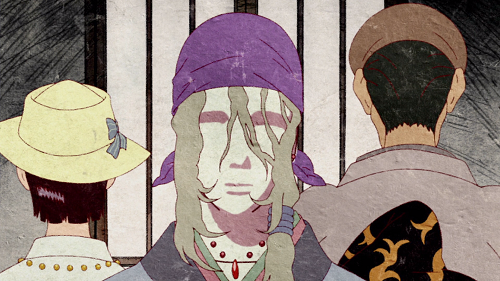
Summary
In what appears to be the 1920s in the late Taisho / early Showa era, the Fukuju Subway Station was celebrating its grand opening with Mayor Jutaro Fukuda hosting the celebration and joining the passengers for their first ride. Detective Sakae (Shakei) Kadowaki rides with the mayor in the first car as a form of security. Reporter Kiyoshi Moriya interviews the mayor. In the second car is Masao Kobayashi, a milk delivery boy. In the third car is widow Haru Yamaguchi who acquired someone else's winning ticket to the subway. In the fourth car are Kusuriuri and Chiyo Nomoto. Chiyo stares at Kusuriuri who nods and smiles at her and quickly acts as if he didn't notice her. Train driver Bunpei Kinoshita sees a woman on the train tracks and stops the train. The aforementioned passengers, with the exception of Kusuriuri, are teleported to the first car, and when they open the door to go to the other cars, the other cars are no longer there. The train begins to move by itself, and the mayor is not seen again, indicating that he fell out of the train car's open door when it moved by itself.
(Spoilers ahead) Haru hears a woman saying "I'll never forgive you", but no one else can hear it. Masao sees something that the other passengers can't see. Kusuriuri enters the car, seemingly from the car behind it, but when Moriya opens the door again, there are no other cars. Kusuriuri introduced himself, saying that he came from another car and that he dresses the way he does to sell his wares. Moriya says the train is moving on its own as if a kitsune is controlling it, and Kusuriuri says this is not a kitsune's doing. Dozens of tenbin fly out of Kusuriuri's backpack, and one bows at Chiyo. The passengers introduce themselves, beginning with Chiyo who is a waitress, to which Kusuriuri responds that she is a shining example of a career woman. Most of the passengers were interrogated by Kadowaki 3-4 months ago about a modern reporter woman named Ichikawa Setsuko who committed suicide over a bridge and got hit by the while Bunpei was driving. Masao delivered milk the morning Setsuko died. The train driver's door opens by itself, and the tenbin tilt. Haru hears cats meowing, and Masao sees a woman holding a cat. Kusuriuri determines the mononoke to be a Bakeneko.
Everyone starts freaking out and seeing and hearing different things. Their skin changes colours as they feel guilt. The passengers admit bits of information that suggest that Setsuko was killed. After their freakout, the train stops at a station, and Kadowaki opens the door to escape. It is actually a trap by the Bakeneko that pulls Kadowaki into it. Masao admits that he saw people at the bridge, and he scratches his eyes as he can't remember what he saw. He disappears, and Haru begins scratching her ear. Moriya says that the mayor, government workers, and construction companies have a vested interest in this subway, and Setsuko made that accusation saying she had undeniable evidence. As he scratches his arm, he says that he was going to allow Setsuko to publish the story, but in reality, he kept turning her down, and now came here to investigate and avenge her death. He scratches all over his body and disappears.
Bunpei says he thought Setsuko's falling body was a cat, and he wasn't going to stop the train at every cat he saw. The passengers realize that Chiyo lied about the details of Setsuko's life and death because she wanted to be famous. Kusuriuri looks at Haru's winning ticket and saw that it belonged to Sakai Shoujiro, a man Haru slept with. Haru and Chiyo start arguing, and Chiyo starts scratching her mouth. Haru says she couldn't have told anyone what she heard outside that night when Setsuko was killed because her mother in law didn't know she was out with another man. Bunpei scratches his legs. The windows on the train break, and Bunpei, Haru, and Chiyo disappear. Moriya reappears from another train car, and Kusuriuri suggests he puts an end to all this.
In a flashback, Moriya actually did not want Setsuko to publish her story, and he demoted her. Setsuko continued investigating and taking photographic evidence of Mayor Fukuda having secret meetings and being bribed to pass city ordinances. After seeing the photos, Moriya allowed Setsuko to write the article for the front page, and Setsuko cried in happiness at being given a chance to be a female reporter. He told her to keep it on the down low and write the article in an inn. Setsuko met with Moriya in secret over a bridge to give him the article, but he burned it when she handed it over. He was working with Mayor Fukuda, so he didn't ever want the article to be printed. Setsuko said she still had her proof, and she could get the story printed in another paper. Reacting to this, Moriya raped Setsuko and pushed her off the bridge. Haru heard Setsuko's screams, and Masao saw Moriya looking down from the bridge. Setsuko was still alive, but couldn't move. A cat came to her and stood over her body, and Bunpei ran the train over her. Detective Sakae only looked at Setsuko's shoes that were arranged neatly by Moriya, so he ruled her death a suicide. Now knowing the kotowari, Kusuriuri exorcises the Bakeneko. The other passengers live and pay respects to Setsuko. Kusuriuri goes on a monologue about mononoke and pets a cat.
Character name etymology
| Name | Meaning |
|---|---|
| Setsuko Ichikawa 市川節子 |
節子 (setsuko): Occasion, period, principles + child. 市川 (ichikawa): City + river. The "occasion" and "period" part of her name highlights the fact that misogyny persists even in a more modern time period. |
| Chiyo Nomoto 野本 チヨ |
Chiyo can mean "thousand years" or "eternal". 野本 (nomoto): Area + blades of grass. Chiyo's first name references the theme of samsara in this show and how Kayo reincarnated into her. If we spell Chiyo with the same kanji for "yo" as in Kayo's name, it would mean "thousand worlds". This makes me think of how misogyny is present in thousands of worlds, in every civilization on Earth, whether it is feudal Japan or western or modern societies. |
| Kiyoshi Moriya 森谷 清 |
清 (kiyoshi): Clear. 森谷 (moriya): Forest + valley. |
| Haru Yamaguchi 山口 ハル |
山口 (yamaguchi): Mountain + mouth. I think it's ironic how her surname has the "mouth" meaning while she was the one hearing things. I wonder why Haru was written with katakana. It could mean "spring". |
| Masao Kobayashi 小林 正男 |
正男 (masao): Right + man. 小林 (kobayashi): Small + forest. |
| Bunpei Kinoshita 木下 文平 |
文平 (bunpei): Writing + even. 木下 (kinoshita): Tree + under. |
| Sakae Kadowaki 門脇 栄 |
栄 (sakae): Prosperity, honor, glory. 門脇 (kadowaki): Gate + side. |
| Jutaro Fukuda 福田 寿太郎 |
寿太郎 (jutaro): Years of age + general suffix for male names. 福田 (fukuda): Good luck / fortune + field. In Chinese Buddhism, it means a "field for growing happiness" or "domain for practices leading to enlightenment". In the show, he was making a profit from building the subway system. The "years of age" meaning of his name might refer to the years men profited from the oppression of women. |
My thoughts
First, for reference, these are the Bakeneko 2 characters and the original bakeneko 1 characters they reincarnated from:
| Bakeneko 1 | Bakeneko 2 |
|---|---|
| Tamaki | Setsuko Ichikawa |
| Kayo | Chiyo Nomoto |
| Sasaoka | Kiyoshi Moriya |
| Lady Mizue | Haru Yamaguchi |
| Katsuyama | Masao Kobayashi |
| Lord Yoshiaki | Bunpei Kinoshita |
| Yahei | Sakae Kadowaki |
| Lord Yoshikuni | Jutaro Fukuda |
| Odajima | A BG character |
I like the similarities between this arc and Bakeneko 1, like how Kusuriuri warned Kadowaki not to leave, and he was eaten by the Bakeneko just like what happened with Yahei in Bakeneko 1. The fact that Haru's ticket was actually won by someone with the surname Sakai might suggest that they are a descendant of Odajima, the last living member of the Sakai household after Bakeneko 1 besides Kayo, but I don't think Kayo would have had the Sakai surname. A more subtle similarity is that Moriya and Sasaoka both did the dirty work for someone with high authority. Moriya tricked Setsuko to help Mayor Fukuda, and Sasaoka helped dispose of Tamaki's body to help Yoshiyuki. Moriya throwing Setsuko's body over the bridge is similar to Sasaoka throwing Tamaki's body down the well. The scenes at the end of each arc, where Tamaki had a flower and rock memorial next to her well and Setsuko had a small flower and newspaper memorial at the bridge, are also similar. The most subtle similarity I found was that in Bakeneko 1, Kusuriuri bled because he tried to use his own strength to push back the Bakeneko, and in Bakeneko 2, he bled because the Bakeneko / Setsuko's pain was just that powerful. It was the pain felt by every woman worldwide across generations.
There are scenes in this arc that remind me of Picasso's art, especially the scenes in the stations when characters have died. Someone said that the window at the place where Moriya and Setsuko spoke about her evidence looks like a fountain pen nib. The details, bros. Other than what's been mentioned, there's not a lot of paintings or significant background art in this arc as there has been in previous arcs. This matches with the decline in accessibility and appreciation for art at the time as Japan's second golden age had ended after the Edo era.
Very interesting how Kusuriuri always scowls in this arc. he looks more tired and done in this arc than the others, and the difference is clear between the apathy in this arc and the playfulness in the previous arc. Also very interesting how he only ever smiled to Chiyo first when they made eye contact and second when he interrogated her, but he never interacted with her in a special way besides that. He knew it wasn't Kayo anyways, and if she was a descendant of Kayo, he didn't need to know. He also smiled when he determined the mononoke to be a Bakeneko.
I also noticed that Kusuriuri seems to be pushing his medicine business more in this arc than usual. He looked for amnesia medication and asked if Moriya wanted a tonic when he looked pale. This, along with his comment about dressing that way in order to sell anything, indicates that he struggles to sell medicine in this time period, so he might have used the situation as an opportunity to be a salesman to people who couldn't leave.
As an Asian person of the Gen Z generation, I am witnessing the decline of apothecaries like Kusuriuri. Growing up, my family members used to take me with them to drugstores that sold traditional herbal remedies, things Kusuriuri would sell. People of my generation only use western medicine (or in my case, nothing at all), so very soon, we will have no need for traditional apothecaries. I wonder what will be of Kusuriuri in the 2023 movie.
His reply to the "kitsune" comment really suggests that he is a kitsune. I think when the taima reacted to Kusuriuri's monologue at the end, it was reacting to his truth or regret. Pretty much all of it is his truth, that he exists to exorcise mononoke, and that they will never be eradicated, so he can never indulge in human emotions that will distract him from his work. At that point, Kusuriuri was done grieving over Kayo and done with human emotions.
Katachi: The Bakeneko was formed from Setsuko's emotions.
Makoto: Setsuko's death was a faked suicide.
Kotowari: Moriya raped Setsuko, pushed her off the bridge, and rearranged her shoes to stage a suicide. Setsuko did not die from the fall, she died when she was run over by the train.
Mononoke 2023

Summary: It's not out yet!
My thoughts
In the trailer, Kusuriuri seems to have a different colour palette. The people who are working on the movie have confirmed that his outfit has been recoloured to black! Aside from the colours, other differences in his design include his bandana looking more like a beanie, his eyebrows being painted dots rather than his natural little triangles, his eye makeup being more detailed, and his hair being dyed at the tips. Eboy Kusuriuri. People liken his new hat to a priest's hat and have drawn his modern design in a priest outfit, but the new design disproves this. I wonder how they will explain his redesign.
The teaser video shows a new design for the sliding doors that has a different design for every arc. The door's design often related to the themes in the story. This door shows a man and a woman and two large serpents with multiple eyes. Large serpents could be the Uwabami yokai which have the power to eat things larger than their bodies (including people), shapeshift into people or objects, control natural disasters, and drink lots of alcohol.
On closer inspection though, the sliding door might actually depict Yamata no Orochi, a giant serpent with 8 heads and tails. The man and woman on the door match with art depicting this legendary creature which often features storm god Susanoo no Mikoto and his wife, Kushinadahime. If the sliding door art is relevant to the story, this might just be the mononoke. Okay, I'm editing this to add that Kusuri-Bako wrote an analysis in 2014 that connected Kusuriuri's taima to the one used by Susanoo to slay Yamata no Orochi as his morror medallion, necklace, and sword are references to the three Imperial Regalia of Susanoo's legend. This might suggest that the 2023 movie will have a plot related to the taima's origins or some other deep Mononoke lore.
There were also some announcements made during the 15th anniversary stream from director Kenji Nakamura that mentioned happiness of the individual vs the happiness of organizations and society not matching. If this announcement has anything to do with the content of the movie, there might be some anticapitalist themes, or the movie might criticize modern Japan's workaholic culture.
One of the announcements states that the film will focus on the ooku part of Edo castle which was only occupied by women. They acknowledge that this series is feminist, and they will keep the movie in line with that.
I've backed the Kickstarter campaign, so I got the tenugui, and tshirt, and I will get the blu-ray once the movie comes out!

Dictionary
General Mononoke terms
- Kusuriuri
- The Medicine Seller, the main character of the series. Though fans tend to use "Kusuriuri" to refer to the character, it is not actually his name, but his occupation. He has no name, so there is not really any other way to refer to him.
- Ayakashi
- A supernatural spirit that are not of this Earth and should not exist, as defined in Umibozu. They come to this world through darkness.
- Mononoke
- An ayakashi combined with a strong human emotion like vengeance, sadness, and fear. "Mono" refers to their godly nature, and "ke" means disease.
- Katachi
- The mononoke's form.
- Makoto
- The mononoke's truth, a physical state, a state of being.
- Kotowari
- The mononoke's reason / regret, a state of the heart / mind.
Kusuriuri's belongings
- Taima
- Kusuriuri's sword, likely a reference to Kusanagi no Turugi or the Vajra Sword of Discriminating Insight.
- Ofuda
- Kusuriuri's talismans that are used to detect and protect from mononoke. They turn red with open eyes when a mononoke is near.
- Tenbin
- Kusuriuri's scales that are used to detect the physical location of mononoke by distance. They tilt in the direction of a mononoke.
- Kusuridansu
- Kusuriuri's backpack that holds his exorcising tools, drugs, and shunga.
- Shunga
- Hentai.
Miscellaneous
- Anzan Daruma
- A daruma doll variation used as a talisman for easy labor and safe delivery of a child.
- Utsurobune
- A ship made by hollowing out a large tree trunk.
Literature
On “Umi Bozu” and an allegorical reading of Mononoke is required reading for anyone who wants to get deep into Mononoke analysis / theories. Take this as an example of how far you can go.
Kusuriuri himself
- Every Friggin Thing You Ever Wanted or Didn't Want to Know About the Medicine Seller
- Kusuriuri's characterization
- What is the Medicine Seller?
- The Medicine Seller is a divine/cosmic mechanism for the creation of life
- The Medicine Seller as Aristotle’s “prime mover”
- The Medicine Seller and Ainu fashion
- Kusuri-bako's Kusuriuri analysis Part 1
- Kusuri-bako's Kusuriuri analysis Part 2
- Kusuri-bako's Kusuriuri analysis Part 3
- Kaigou's Kusuriuri analysis Part 1
- Kaigou's Kusuriuri analysis Part 2
- Kaigou's Kusuriuri analysis Part 3
- Kusuriuri clothing analysis Part 1
- Kusuriuri clothing analysis Part 2
Mononoke on a broader scale
- What are Ayakashi?
- Form, Truth, Reason
- Materiality, Mystery and Meaning in Mononoke
- Haunted World: Sympathy for the Devil
- Mononoke are made of love
- Buddhist and Islamic theory of Mononoke
- Mononoke characters and obliviousness
- Fear and the fragmented mind
- Mononoke and meditation
- Women in Mononoke
- Reading Mononoke as feminist
- Kayo and the idea of an ideal wife
- Reestablishing a relationship with love
- Escaping from the past
Fine Art
Memes and AMVs I like
There's also 【怪化猫/治愈向】世間萬情,如七彩之蝶 which was deleted from NND. The original song is 虹色蝶々 by Wagakki Band.
Artifacts
Please see Kaigou's Ayakashi: Bakeneko analysis that goes into detail about everything we see here. I will add more details and interpretation here.
Kusuriuri shows these objects to Kayo when he tells her of remedies for a newly married couple, hinted to be aphrodisiacs.
Screenshot 1
The pot thing looks like a bronze and gold incense burner, but I can't find the significance of the abnormally long serpent heads. The item on the back left looks like a bronze statue with patina of Hindu deity Ganesh, but I don't see a trunk. I don't know if Ganesh is associated with rings. There are some pendants or amulets on the floor that resemble a humanoid and an elephant.
Screenshot 2
The object in the middle looks like a chameleon pot with a monkey on top. The thing in the back looks like a stone or clay box. The face to me doesn't look like anything I've seen on an Asian artifact. It might be South American, and because of the blocky, geometric style, I think it is Mayan or Aztec. I don't know how Kusuriuri would have gotten his hands on it. Maybe I'm overthinking it.
Screenshot 3
First, the turtles. Turtles, especially when stacked, symbolize longevity, good luck, and support in Japan. In China, turtles can be used as medicine. Turtles are sometimes featured in traditional Japanese wedding ceremonies, as Bakeneko 1 took place when Lady Mao was about to get married. Stacked turtles can also represent generations of a family. When Kayo told Kusuriuri about Mao's fiance's "problem", the turtles are shown fallen on their backs, further suggesting that the problem is related to erectile dysfunction that would end the family line.
The falling turtles might also foreshadow the end of the Sakai family at the end of the arc. Stacked turtles are normally shown in groups of 3, so why are there 4 stacked turtles in Bakeneko 1? Note how the smallest turtle has a brighter coloured shell than the others. I think the four turtles reresent the three generations (Yoshiyuki, Yoshiaki, Lady Mao) and the generation of Lady Mao's potential children. The one lone turtle on the side might represent an outsider looking in, like Kayo. I wonder why this turtle has a ring on its shell.
The object on the back left looks like a weird elephant. In Asia, elephants represent wisdom, strength, and royal power.
The object on the back right looks like Pixiu, a Chinese winged lion that is a protector and figure of wealth.
